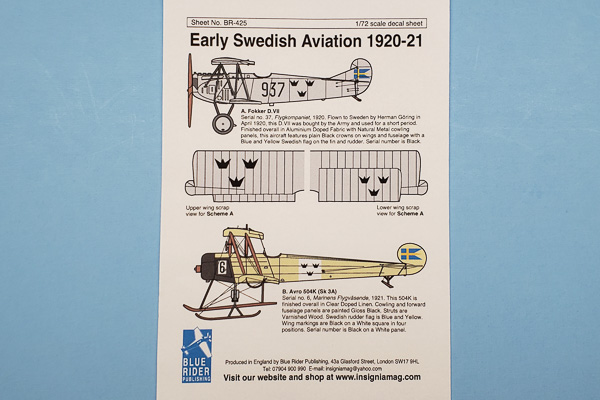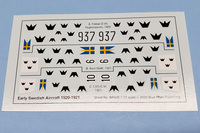
Blue Rider 1/72 Early Swedish Aviation 1920-21
By Chris Banyai-Riepl
Overview
Smaller air forces are often a great way to show common aircraft in uncommon markings, but it can be challenging to find decals for these nations. When you figure in early aviation, it gets even more difficult, as often these markings differed from later iterations. Such is the case for Swedish markings, with early examples consisting of black crowns for the national markings, and a pennant-style Swedish flag on the rudder. Luckily for us modelers, Blue Rider tends to highlight these smaller air forces, and this sheet focuses on these early Swedish markings.
The Decals
While current Swedish aircraft are dominated by Saab designs, back in the 1920s the country had to look outside its borders for its aviation needs. That result is reflected in this decal sheet, which provides markings for a Fokker D.VII, an Avro 504K, and an LVG C.VI. Sweden only had a single Fokker D.VII, two LVGs, and five 504Ks (along with a single 504N).
 Starting with the Fokker D.VII, this was a Fokker-built type, serialed F.7716/18, that was flown to Sweden by Hermann Göring in April of 1920. As this was a post-war aircraft, it was delivered without any armament. It was finished in overall aluminum dope with unpainted metal panels. The black crowns were on the top of the upper wing and bottom of the lower wing, as well as the fuselage sides. The fuselage side also gets the aircraft number of 937, while the tail has the Swedish flag. Photos of this plane show it to be pretty clean overall, as it was repainted in Sweden. For those interested in doing a before & after pair, the plane arrived in Sweden in an attractive black and white striped scheme, with lozenge lower wings. The vertical stripe of the fuselage cross was left in place, but the horizontal bars were painted out in white. Also painted out were the tail crosses and the black portion of the upper wing crosses. I suspect similar treatment was done to the lower wing crosses, but no photos exist showing that, at least that I know of.
Starting with the Fokker D.VII, this was a Fokker-built type, serialed F.7716/18, that was flown to Sweden by Hermann Göring in April of 1920. As this was a post-war aircraft, it was delivered without any armament. It was finished in overall aluminum dope with unpainted metal panels. The black crowns were on the top of the upper wing and bottom of the lower wing, as well as the fuselage sides. The fuselage side also gets the aircraft number of 937, while the tail has the Swedish flag. Photos of this plane show it to be pretty clean overall, as it was repainted in Sweden. For those interested in doing a before & after pair, the plane arrived in Sweden in an attractive black and white striped scheme, with lozenge lower wings. The vertical stripe of the fuselage cross was left in place, but the horizontal bars were painted out in white. Also painted out were the tail crosses and the black portion of the upper wing crosses. I suspect similar treatment was done to the lower wing crosses, but no photos exist showing that, at least that I know of.
Next up on the sheet is the Avro 504K, which was later known as the Sk 3 when the aircraft were transferred to the Swedish Air Force from the Swedish Navy. The scheme provided on the decal sheet dates from the aircraft's naval service and is finished in overall clear doped linen with a black cowling and metal panels around the nose. The black crowns on this aircraft were painted onto a white background on the fuselage side and the top of the upper wing. There were no markings carried on the underside. The Swedish flag once again makes an appearance on the rudder, and the individual aircraft number 6 appears in black on a white panel on the forward nose. The instructions identify this as an Sk 3A, but that is incorrect as the Sk 3A was the sole Avro 504N obtained in 1926 for evaluation. The Sk 3A differed from the Sk 3 in several ways, most visually by the improved landing gear that eliminated the central skid. The original Sk 3s remained in service until 1928.
The final option on this sheet is the LVG C.VI. This is probably the most obscure when it comes to colors & markings, as there are very few photos of this plane in Swedish service. The most common theory is the standard German scheme of varnished plywood fuselage with lozenge-covered wings and a white vertical fin. However, some photos show a more uniform look overall, suggesting that perhaps the plane was painted a single color, while some other photos hint at the possibility of CDL wings and tail surfaces. With only two aircraft in service (numbers 9 and 10), it is possible that they had a combination of all these schemes in the short time they were in operations, simply from a maintenance side. The decals represent aircraft #10 and depict it with a varnished fuselage with black-painted metal panels, lozenge wings, and a white fin. The national markings are on a white background, and the Swedish flag is on the rudder.
Conclusion
These decals are nicely printed and while fairly simplistic, they capture the look of the original quite well. With the Eduard Fokker D.VII and the KP LVG C.VI, two of these subjects are very well represented in modern kits. Unfortunately, for the Avro 504 there are few options and all have some pretty big shape issues. Maybe the modeling gods will smile on us soon, though, and grant us with a new-tool 504 family. Regardless of kit selection, this is a great decal sheet to pick up if you're looking for something a little different on your shelf. My thanks to Blue Rider for the review sample.
